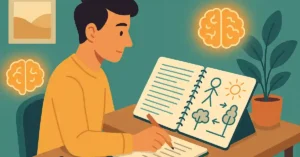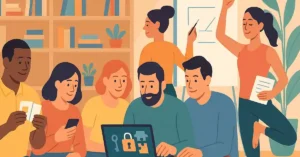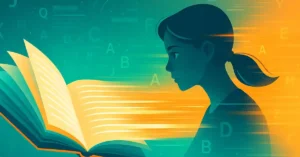Picture me, a grown-up with coffee in one hand and a stack of plain, boring notes in the other. Now picture those notes magically morphing into bright sketches, stick-figure timelines, and color-coded arrows that practically beg my brain to remember them. That, my friends, is the dual coding study strategy in action—mixing words and images so your memory hangs on tight.
Below, I’ll break down what dual coding is, why science says it works, and how you (yes, even if your last doodle was in third grade) can use it to turbo-charge everything from language learning to workplace training.
1. What Exactly Is Dual Coding?
Dual coding comes from psychologist Allan Paivio’s Dual Coding Theory. He proposed that we have two main “channels” for information—one verbal, one visual—and when we learn with both, we double-zip-lock ideas into memory. (Masterplan)
In everyday language: pair text with a picture, diagram, or even a mental image, and your brain forms two routes back to the same idea. Later, if one path is foggy, the other still gets you home.
2. The Science: Why It Sticks
Meta-analysis magic: A 2024 systematic review of 43 studies found that combining visuals and words significantly boosts understanding and long-term recall across ages and subjects. (SpringerLink)
Reduced cognitive traffic jams: Visuals lighten the load on your verbal working memory, freeing up mental bandwidth for deeper thinking. (St.Emlyn’s)
Better retention: Classroom research (middle school through university) shows higher test scores when dual coding is used versus text-only study.
Corporate thumbs-up: Learning-and-development specialists report that mixing icons, infographics, and stories keeps adult trainees engaged and boosts on-the-job performance. (Training Industry)
Translation: dual coding isn’t just a cute classroom gimmick—grown-ups reap the benefits too.
3. Why Adults Should Care
Complex material, clearer brain: Whether it’s project-management frameworks or Italian verb tenses, dual coding untangles dense info.
Time efficiency: Studying while juggling work, family, and Netflix means every minute counts. Visual-verbal pairs cut re-read time.
Long-term career leverage: The faster you absorb new skills (hello, AI tools!), the quicker you stay relevant.
Creative spark: Sketching concepts nudges parts of the brain linked to innovation—handy for problem-solving meetings.
4. Getting Started: My Foolproof Five-Step Method
Step 1: Chunk Your Material
Break that beefy chapter or training manual into bite-sized points (definitions, processes, cause-and-effect chains). Short chunks keep visuals from turning into Picasso chaos.
Step 2: Choose the Right Visual
Concept maps for relationships
Timelines for history or project stages
Diagrams (flowcharts, cycles, Venns) for processes or comparisons
Sketch-notes for mixed lists, quotes, and doodles
Flashcards with images for vocab, formulas, or job acronyms
No artistic flair? Stick figures and arrows work just fine.
Step 3: Pair Words + Picture Side by Side
On a notebook page, split the sheet. Left column = concise explanation in your own words. Right column = drawing, symbol, or color-coded chart. The pairing must be simultaneous—looking back and forth is what fires both channels.
Step 4: Retrieve, Don’t Reread
Cover one side, recall the other. Flip. Repeat. Retrieval practice cements the dual pathways far better than rereading alone.
Step 5: Spaced Revisit
Return 24 hours later, then a week, then a month. Each revisit, tweak visuals or add colors as insights deepen. Spaced repetition plus dual coding forms a memory power couple.
Master Speed Reading and Memory
Unlock the secrets of speed reading and memory mastery. This practical guide helps you boost your reading speed, sharpen recall, and learn smarter—starting today.
5. Real-World Scenarios
A. Learning a New Language
Write “dog = perro” on the left. Draw a goofy-grinning dog wearing a sombrero on the right. When you need the Spanish word, that dog pops up before you can say “gracias.” Language bloggers highlight dual coding as a top tool for vocab mastery. (Sandy Millin)
B. E-Learning Modules at Work
Transform text-heavy slide decks into infographics: icons for each safety procedure, arrows showing workflows, or micro-animations. Companies see higher course-completion rates and fewer “Where’s the mute button?” webinars.
C. Professional Certification Exams
Create flashcards with formula names on one side and color-coded diagrams on the other. The picture triggers the formula under pressure. Results: calmer test day, happier brain.
D. Public Speaking & Presentations
Replace bullet-block slides with a single compelling graphic plus a keyword. Your audience follows the image while your voice fills in the details—dual coding for them and for you as you rehearse.
E. Personal Development Reading
While reading a self-help chapter, jot a quick cartoon representing the main idea (e.g., a battery for “recharge rituals”). Later, scanning your notebook is like flipping a graphic novel of wisdom.
6. Digital Tools to Make It Easy
Canva or PowerPoint: Quick icons, diagrams, and color palettes.
Notion or OneNote: Mix typed notes with pasted images or hand-drawn sketches on tablets.
Anki or Quizlet: Insert pictures alongside prompts for spaced-repetition flashcards.
GoodNotes or Procreate (iPad): Hand-draw concept maps, then export as study sheets.
Mind-mapping apps (XMind, Coggle): Turn lists into branching visuals faster than a squirrel on espresso.
7. Common Pitfalls (and How to Dodge Them)
Image overload: Ten pictures on one slide ≠ dual coding; that’s cognitive clutter. Stick to one clear visual per idea.
Copy-paste syndrome: Borrowed graphics can help, but personal sketches (yes, zig-zag stick people) glue ideas to your memory better.
Passive gazing: Simply looking at a diagram won’t cut it. Build it, label it, explain it aloud—make your brain sweat (a little).
Neglecting review: Dual coding isn’t a silver bullet without spaced retrieval. Mark calendar reminders.
Perfection paralysis: Ugly visuals are still effective. Remember: you’re making memory, not museum art.
8. Frequently Asked (and Slightly Silly) Questions
Q: I draw like a sleepy potato. Will this still work?
A: Absolutely. Your brain cares more about connections than beauty. Think of your doodles as private brain graffiti.
Q: Can I dual-code with audio instead of visuals?
A: You can pair text with spoken explanations (audio), but you’ll miss the visual channel’s unique strengths. Try adding a quick sketch too for best results.
Q: Isn’t this just mind mapping with extra steps?
A: Mind maps are one dual coding technique. The strategy is broader: any deliberate pairing of words and visuals counts.
9. Wrapping Up (In Doodles and Words)
The dual coding study strategy isn’t a fancy buzzword—it’s a straightforward, research-backed way to make learning stick like velcro. By consciously blending concise text with simple visuals, adults can slash study time, boost recall, and even spark a dash of creativity at work and home.
Next time you need to learn something new—whether it’s Python loops, Italian idioms, or your company’s labyrinthine HR policy—grab a pen, sketch a quick diagram, and let your two learning channels high-five each other. Your future, better-informed self will thank you (and probably doodle you a smiley face in return).







